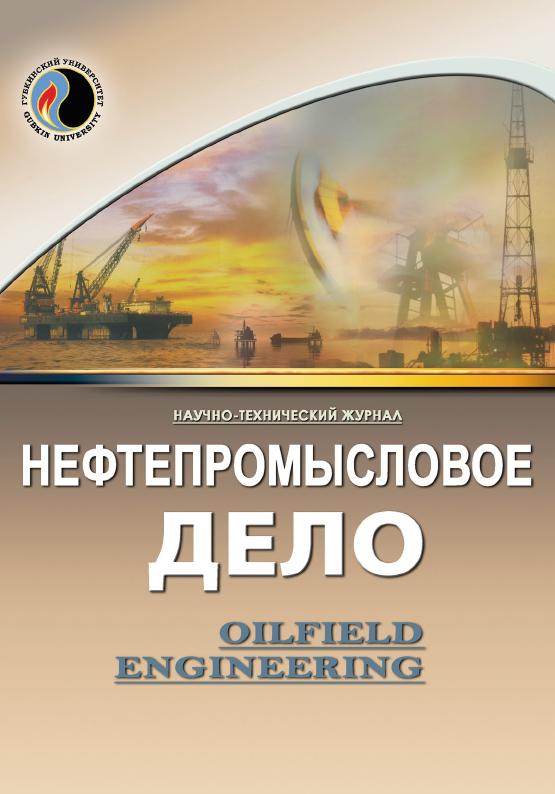Scientific and technical journal
«Oilfield engineering»
ISSN 0207-2351

A metod for applying a multilayer model for interpretation of well hydrodynamic at the West Qurna 2 field
UDC: 622.276.346
DOI: 10.33285/0207-2351-2023-5(653)-51-57
Authors:
1 National University of Oil and Gas "Gubkin University", Moscow, Russia
2 LUKOIL-Engineering, Moscow, Russia
Keywords: wells hydrodynamic test studies, well logging, production logging test, reservoir properties, heterogeneity, multi-layer reservoirs, inter-layer cross-flows, multilayer model, permeability, skin-factor
Annotation:
The West Qurna 2 field is currently a strategically important project of LUKOIL PJSC, due to which a special attention is paid to additional study and clarification of its characteristics. Every year, more than 100 wells hydrodynamic tests (WHDT) and production logging tests (PLT) are carried out at the field. A joint analysis of the WHDT and PLT interpretation data made it possible to identify the presence of inter-layer cross-flows in the reservoir and their influence on the pressure behavior. According to the analysis results as well as the results of well logging, indicating a high heterogeneity of the production interval, the standard approach to WHDT interpretation using homogeneous reservoir models and double permeability reservoir model does not allow precise characterization of the producing section by the determined parameters. The appliance of the multilayer model is justified by the geological structure of the field, but there are significant difficulties of applying this model for practical calculations. The most significant one is determination of permeability and skin factor for each layer. At the same time, there are no criteria by which these values can be clarified. This article presents the developed methodology for determining criteria and algorithms for the input parameters calculation, necessary for the data interpretation obtained during wells hydrodynamic test studies of the West Qurna 2 field, using a multilayer reservoir model.
Bibliography:
1. Osobennosti izucheniya fil’tratsionnykh kharakteristik orientirovannogo kerna slozhnopostroennykh karbonatnykh kollektorov / I.P. Gurbatova, V.V. Plotnikov, N.A. Popov, I.V. Sysoev // Vestn. Permskogo natsional’nogo issledovatel’skogo politekhnicheskogo un-ta. Geologiya. Neftegazovoe i gornoe delo. – 2013. – № 9. – C. 79–86.
2. Soleimani Sh., Hashemi A., Kharrat R. Challenges in Well Testing Data from Multi-layered Reservoirs and Improving Nonlinear Regression: A Gas filed // J. of Oil, Gas and Petrochemical Technology. – 2017. – Vol. 4, № 1. – P. 85–98.
3. Livintsev P.N., Sizov V.F. Razrabotka neftyanykh mestorozhdeniy: ucheb. posobie. Kurs lektsiy. – Stavropol’: Severo-Kavkazskiy federal’nyy universitet, 2014. – 132 c.
4. Kodhelaj N., Bozgo Shkёlgim. Role of Well Testing and Information in the Petroleum Industry–Testing in Multilayers Reservoirs. – 2016.
5. Park H., Horne R. Well test analysis of a multilayered reservoir with formation crossflow // SPE Annual Technical Conference and Exhibition, 8–11 Oct. 1989, San Antonio, Texas. – URL: https://doi/org/10.2118/19800-MS
6. Spivey J.P. Estimating Layer Properties for Wells in Multilayer Low Permeability Gas Reservoirs by Automatic History-Matching Production and Production Log Data // Gas Technology Symposium, Calgary, Alberta, Canada, 2006. – DOI: 10.2118/100509-MS
7. Eskandariniya M., Hashemi A., Zareiforoush A. Challenges in Well Testing Data from Multi-Layered Reservoirs; a Field Case // International J. of Engineering. Sci. Emerging Technologies. – 2012. – Vol. 4(6).
8. Raghavan P.R. Well Test Analysis for Wells Producing Layered Reservoirs with Crossflow // Soc. Pet. Eng. J. – June 1985. – P. 407–418.
9. Houzé O., Viturat D., Fjaere O.S. Dynamic Data Analysis. The Theory and Practice of Pressure Transient Production Analysis, Well Performance Analysis, Production Logging and the Use of Permanent Downhole Gauge Data. – SophiaAntipolis: Kappa, 2011. – 414 p.
10. Maksimova E.N., Parfenov N.A., Belezerov B.V. Kompleksnyy podkhod k adaptatsii pronitsaemosti na osnove sovmestnoy interpretatsii metodov GIS i GDIS // SPE-191690-18RPTC-MS. – 2018. – S. 1–23.
11. Gidrodinamicheskie issledovaniya skvazhin: analiz i interpretatsiya dannykh / T.A. Deeva, M.R. Kamartdinov, T.E. Kulagina, P.V. Mangazeev. – Tomsk, 2009. – 240 s.
12. Koskov V.N., Koskov B.V. Geofizicheskie issledovaniya skvazhin i interpretatsiya dannykh GIS: ucheb. posobie. – Perm’: Izd-vo Permskogo gosudarstvennogo tekhnicheskogo un-ta, 2007. – 317 s.
13. Instruktsiya po provedeniyu GDI i GKI na gazovykh i gazokondensatnykh mestorozhdeniyakh PAO "LUKOIL". Versiya 1.0. – M.: OOO "LUKOIL–Zapadnaya Sibir’", 2021. – 85 s.
14. Ponomareva I.N., Erofeev A.A. Gidrodinamika plastovykh sistem. Metodicheskie ukazaniya dlya vypolneniya laboratornykh rabot. – Perm’: PNIPU, 2011. – 65 s.
15. Metodicheskoe i prakticheskoe rukovodstvo po gidrodinamicheskim i trassernym issledovaniyam na mestorozhdeniyakh gruppy "LUKOIL". – M.: OOO "LUKOIL–Inzhiniring", 2018. – 437 s.
16. Zapadnaya Kurna-2: Realizuya masshtabnyy proekt. – URL: https://lukoil.ru/Business/Upstream/Overseas/WestQurna-2 (data obrashcheniya: 20.01.2023).